NEEDVILLE WATER TOWER WILL STAY STANDING FOR NOW ON ACCOUNT OF IT MIGHT BE COVERED IN LEAD Needville’s city council appeared unmoved by local preservationists’ 2-year campaign to repaint and rehab the town’s signature WWII-era water tower earlier this month when it voted 3-2 to demolish the, um, patinaed structure. But just last Friday, 2 people with land near the tower took a new approach to preserving it, arguing in district court that the structure’s worth saving not just for its looks but because lab tests, their attorney wrote, showed that its exterior “was coated with six layers of lead-based paint,” each containing a high level of the chemical. A temporary restraining order granted against the City of Needville the same day now bars anyone from toppling the tower until “safety protocols are established by competent experts,” to ensure that “no environmental contamination” will result from the teardown. (“The contractor hired by the city council is a nice guy,” one of the plaintiffs, Rick Sinclair, told the Chronicle’s Kristi Nix, “but I don’t believe he is licensed or accredited to handle this level of lead abatement.”) A hearing to consider the lawsuit is now set for January 19. According to the plaintiffs, “Restoration coating systems have been identified” that would protect the tower while also sealing in the lead. [abc13] Video: Picture Perfect Productions
Historic Preservation

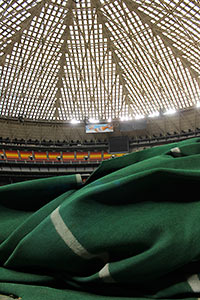
Just in time for Christmas, Preservation Houston has begun marketing a new type of Astrodome memorabilia: 4-in. beverage-coaster-sized squares of AstroTurf removed from the stripped-down stadium — along with loads of other major league hardware — in October 2013. Each one bears “a unique serial number and a certificate of authenticity,” according to the seller, and they come in packs of 4 that cost $100, plus tax. (That’s more than a 200-percent price hike since the last big Astrodome yard sale 5 years ago offered up 12-in.-by-12-in. squares for $20 each.)
During the lead-up to the defeated 2013 bond proposal that would have paid for extensive renovations to the Astrodome, these particular patches of turf road along with staffers from the National Trust onboard the “Dome Mobile,” a 26-ft. truck that the preservationist organization commandeered as part of a public campaign to save the building from demolition. It wasn’t until afterward that Preservation Houston got its hands on them en masse. Shipments of the items, it now says, should be delivered to buyers no later than December 17.
- Astroturf coasters [Preservation Houston]
- Astrodome coverage [Swamplot]
Photos: Preservation Houston
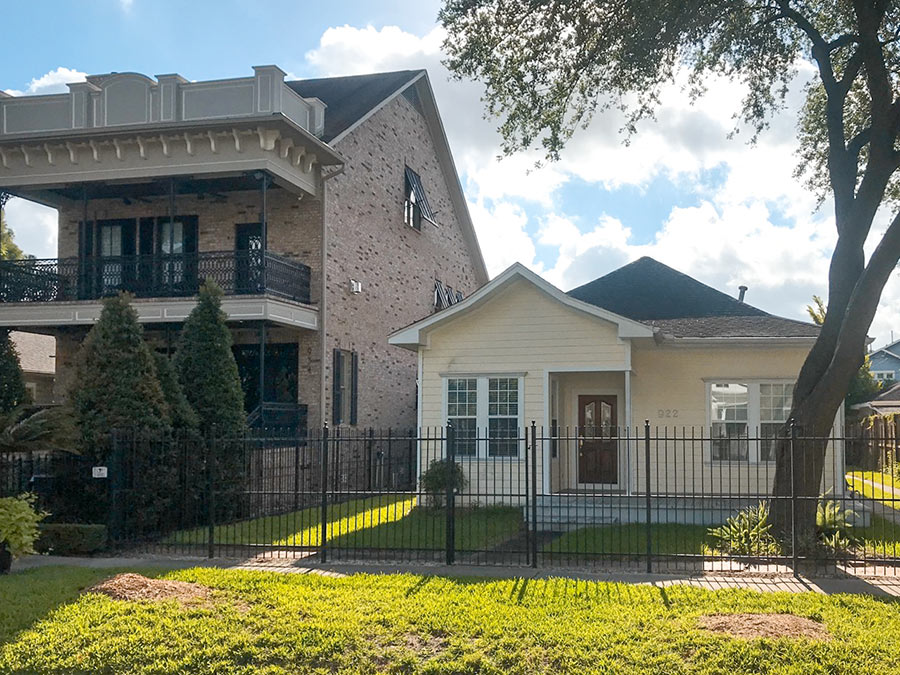
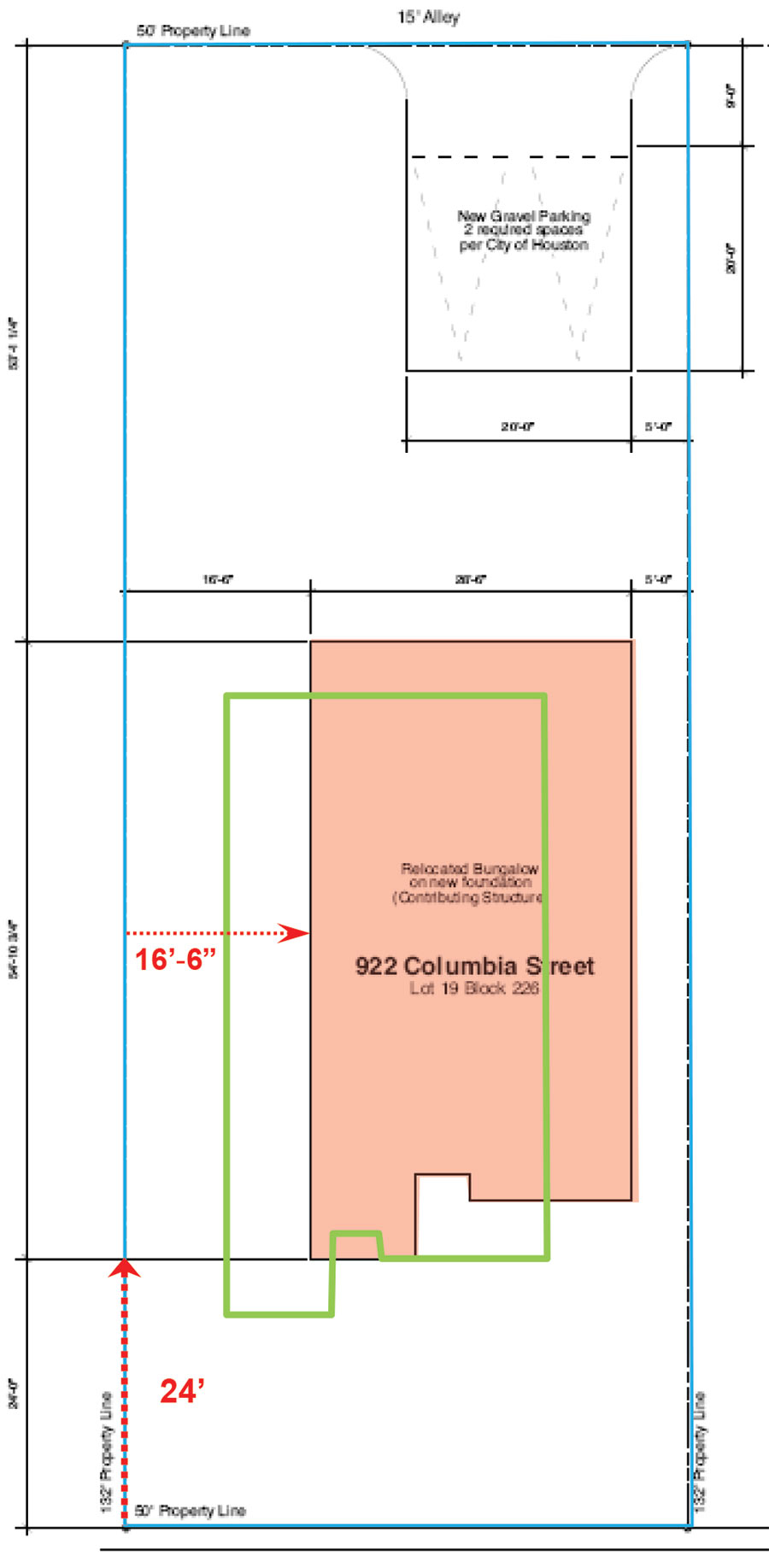
After the owner of the yellow bungalow went to jail in 2015 for conspiracy, the townhome neighbors bought it and begun looking to put some distance between the house and their own. Last Wednesday, the city’s historical commission reviewed their plans however and told them no can do. The extra 7-ft.-8-in. they wanted to add between the 2 structures would take the bungalow — part of the Heights South Historic District — out of its original 1920 location at 922 Columbia St. And the other change — sliding it 5-ft.-3.5-in. back from the curb to line up with its taller neighbor — would make it less prominent along the street.
The decision is binding, so there’s no shying away now from the current situation:
WHAT CHANCE WOULD THE KIRBY MANSION STAND TO STAY STANDING UNDER NEW OWNERSHIP? 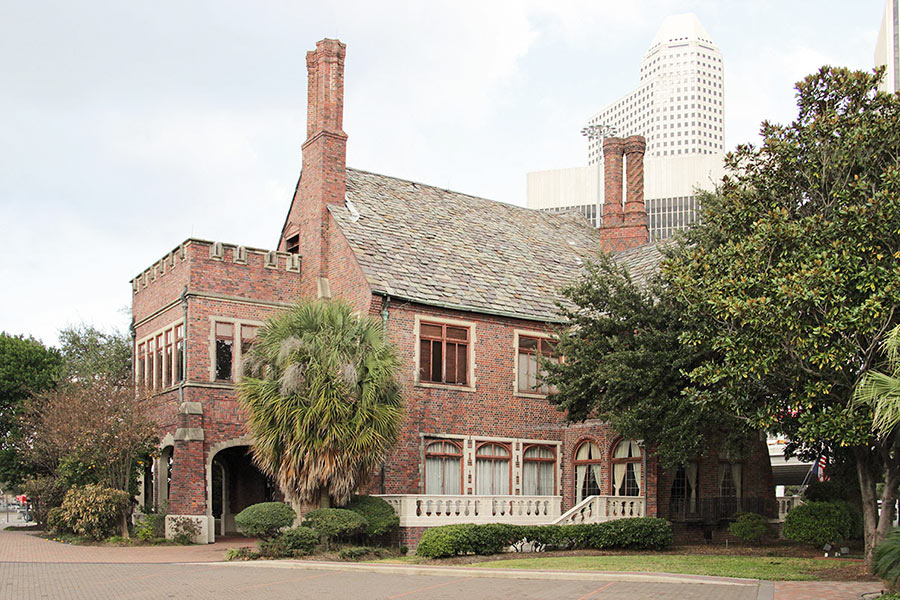 The demolition watchdogs over at Preservation Houston report that a buyer has the 36-room Midtown mansion on the corner of Pierce and Smith St. under contract and “does not intend to retain the building.” Seeking to thwart a teardown, Houston historic commission chair Minnette Boesel met with seller Phlip Azar last week — reports Nancy Sarnoff — and urged him to find someone instead who’ll keep the place upright. Aside from the house’s pedigree (built in 1894 for John Henry Kirby, it was expanded and remodeled 32-years later by architect James Ruskin Bailey), the Tudor at 2006 Smith St. has state and federal tax credits to offer any developer that renovates it for commercial use. That’s what its last would-be buyer Dennis Murphree hoped to do 3 years ago before the sale fell through. His plan: build a 15-story office tower designed “to look as much like the mansion as possible,” right next door to it — reported Sarnoff — and incorporate the 18,000-sq.-ft. house into the complex.[Preservation Houston; more info] Photo: Preservation Houston/The Heritage Society
The demolition watchdogs over at Preservation Houston report that a buyer has the 36-room Midtown mansion on the corner of Pierce and Smith St. under contract and “does not intend to retain the building.” Seeking to thwart a teardown, Houston historic commission chair Minnette Boesel met with seller Phlip Azar last week — reports Nancy Sarnoff — and urged him to find someone instead who’ll keep the place upright. Aside from the house’s pedigree (built in 1894 for John Henry Kirby, it was expanded and remodeled 32-years later by architect James Ruskin Bailey), the Tudor at 2006 Smith St. has state and federal tax credits to offer any developer that renovates it for commercial use. That’s what its last would-be buyer Dennis Murphree hoped to do 3 years ago before the sale fell through. His plan: build a 15-story office tower designed “to look as much like the mansion as possible,” right next door to it — reported Sarnoff — and incorporate the 18,000-sq.-ft. house into the complex.[Preservation Houston; more info] Photo: Preservation Houston/The Heritage Society
COMMENT OF THE DAY: THERE’S MORE MONEY IN HISTORY 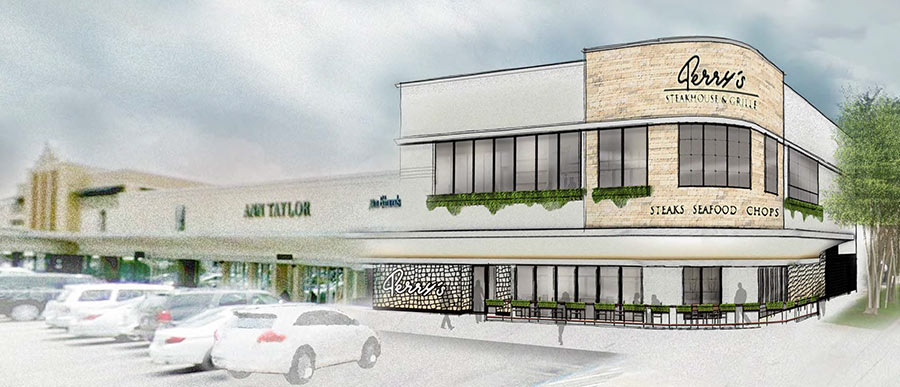 “First of all, this really doesn’t make much difference, as the original art moderne lines of this center were destroyed several years ago with the addition of gun turrets on the corners of the buildings.
What I do find interesting is that Weingarten talks about the alterations as being financially responsible decisions to their shareholders. Yet this is the 3rd oldest intact shopping center in the US, and the only two that predate it, AFAIK, are Highland Park Village in Dallas and Country Club Plaza in Kansas City. Both of those have owners that have restored them to essentially their original designs and have enjoyed much increased property values. In the case of Highland Park Village, Henry S Miller (a Dallas developer) bought HP Village in the later ’70’s as it was very run down and dumpy, and had the foresight to restore its original Spanish Colonial design and garner a better tenant mix. Though his company no longer owns it, HP Village commands far higher square foot rents than River Oaks Shopping Center. All this is to say that if Weingarten had invested money in restoring their property 10-15 years ago, they probably would have a more valuable asset today.” [ShadyHeightster, commenting on The Other River Oaks Shopping Center Knockdown Hearing Scheduled for This Week] Rendering of proposed alterations to River Oaks Shopping Center, 1997 West Gray St.: Aria Group Architects for Weingarten Realty Investors
“First of all, this really doesn’t make much difference, as the original art moderne lines of this center were destroyed several years ago with the addition of gun turrets on the corners of the buildings.
What I do find interesting is that Weingarten talks about the alterations as being financially responsible decisions to their shareholders. Yet this is the 3rd oldest intact shopping center in the US, and the only two that predate it, AFAIK, are Highland Park Village in Dallas and Country Club Plaza in Kansas City. Both of those have owners that have restored them to essentially their original designs and have enjoyed much increased property values. In the case of Highland Park Village, Henry S Miller (a Dallas developer) bought HP Village in the later ’70’s as it was very run down and dumpy, and had the foresight to restore its original Spanish Colonial design and garner a better tenant mix. Though his company no longer owns it, HP Village commands far higher square foot rents than River Oaks Shopping Center. All this is to say that if Weingarten had invested money in restoring their property 10-15 years ago, they probably would have a more valuable asset today.” [ShadyHeightster, commenting on The Other River Oaks Shopping Center Knockdown Hearing Scheduled for This Week] Rendering of proposed alterations to River Oaks Shopping Center, 1997 West Gray St.: Aria Group Architects for Weingarten Realty Investors
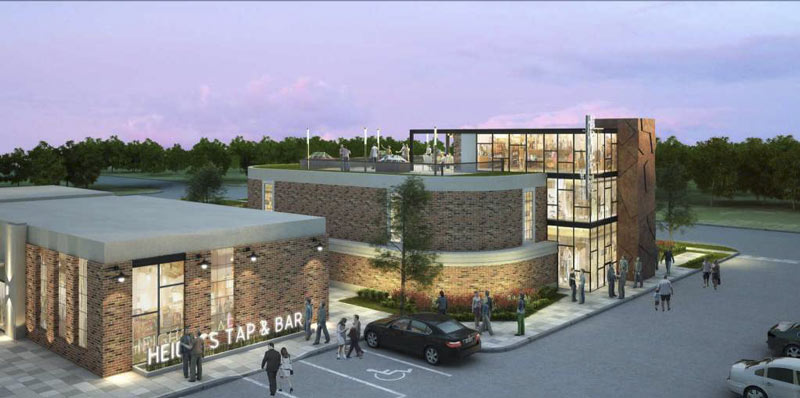
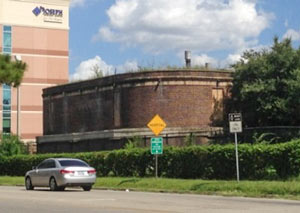 A segment of the Heights Waterworks properties at 20th and Nicholson St. should be making its way into the hands of Braun Enterprises later this year, Katherine Feser reports this morning in the Chronicle. Building on Houston’s budding tradition of high profile redevelopment of decommissioned water storage tanks, the company will be turning the handful of pump station and reservoir structures on the block southeast of 20th and Nicholson into a handful of restaurants and bars, catty-corner from Alliance’s planned apartments.
A segment of the Heights Waterworks properties at 20th and Nicholson St. should be making its way into the hands of Braun Enterprises later this year, Katherine Feser reports this morning in the Chronicle. Building on Houston’s budding tradition of high profile redevelopment of decommissioned water storage tanks, the company will be turning the handful of pump station and reservoir structures on the block southeast of 20th and Nicholson into a handful of restaurants and bars, catty-corner from Alliance’s planned apartments.
One of the features called out in the city’s 2015 declaration of the property as a protected landmark was the “unusual grass roof” atop the reservoir itself; Tipps Architecture’s design for the structure’s redevelopment shows some grass in place on a rooftop patio, as well as a 3-story glassy extension protruding from the east face of the 2-story building. Other views of the complex show a lawn in between the building labeled Heights Tap & Bar above and the pumphouse to the south:
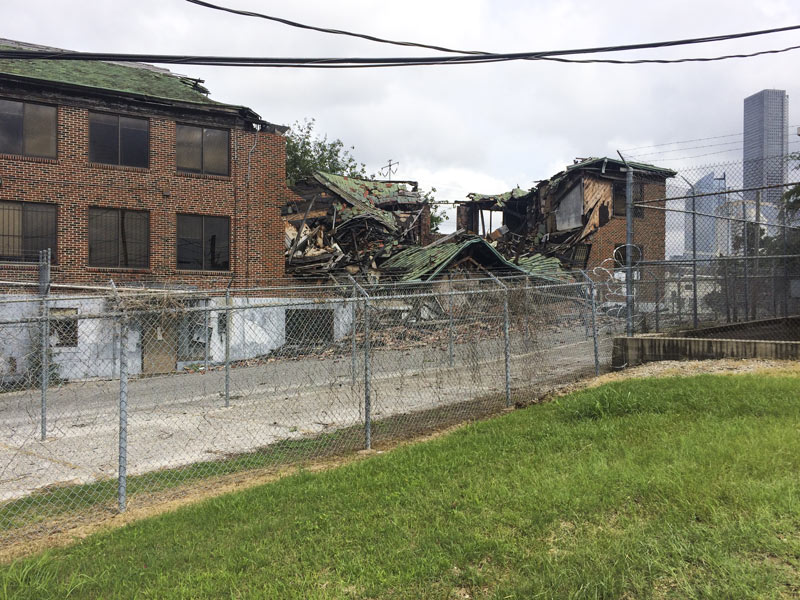
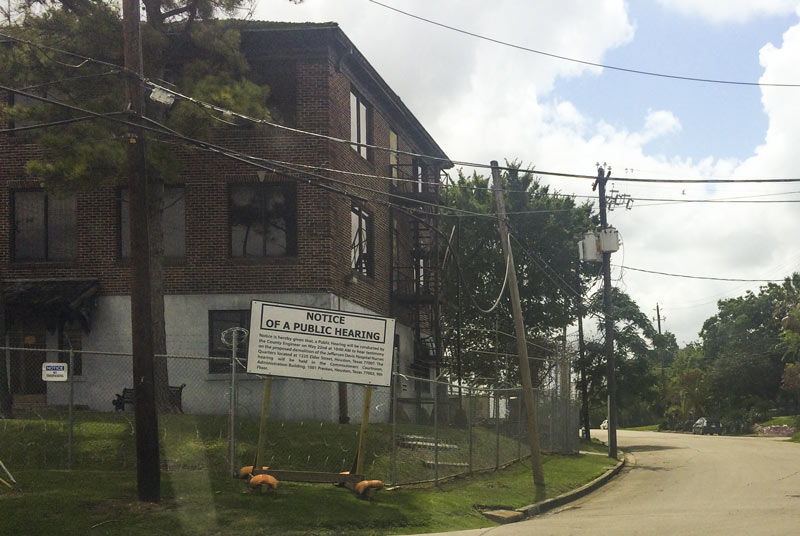
The partially ruined former Jefferson Davis Hospital nurses quarters at 1225 Elder St. — until very recently in the running for a spot on the National Register of Historic Places — was recommended for demolition at last week’s Harris County Commissioner’s Court meeting following a public hearing the day before. The building, tucked west of the elevated freeway tangle where I-45 splits from I-10 near Downtown, would have joined the nextdoor former Jefferson Davis Hospital itself on the historic registry — instead, it looks like the structure will finally meet meet the ‘dozers after its long slow decline, accelerated by damage from a fire in 2013 that lead to last year’s semi-collapse.
Next door, the 4-story hospital structure (built in 1924, and replaced by 1938 with another Jefferson Davis Hospital where the Federal Reserve building now stands on Allen Pkwy.) cycled through various modes of use and disuse until its early 2000’s restoration into the Elder Street Artist Lofts, which serve as low-rent apartments and studios for artsy types. That redevelopment, of course, involved carefully digging around the dozens of unmarked graves turned up on the surrounding land, which beginning in 1840 had served as the second city cemetery (and as the final resting place for a hodgepodge likely including  Confederate soldiers, former slaves, victims of the 1860s yellow fever epidemics, people who died in duels, Masons, and a variety of others). The hospital’s name is still carved above the lofts’ entrance:
BART TRUXILLO, 1942-2017 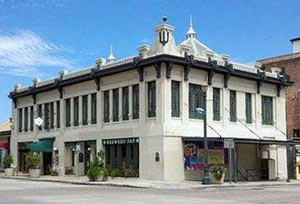 In 2006, the former brewery structure now hosting the Magnolia Ballroom was the first building in Houston to get protected landmark status — and was not the last, probably thanks in part to the life work of its restorer. Bart Truxillo bought the then-vacant building on the edge of Market Square in the late sixties, not too long before buying and restoring the crumbling Queen Anne Mansfield house in the Heights; both structures are now on the National Register of Historic Places. Truxillo later helped found what’s today known as Preservation Houston, and start the organization’s Good Brick Awards during the demolition-rich years of Houston’s first oil boom, as Lisa Gray notes today in the Chronicle; after years of work restoring historic buildings around town and serving a bunch of other history-minded groups, he died yesterday at age 74. [Houston Chronicle; previously on Swamplot] Photo of Magnolia Ballroom building on Franklin St.: Brewery Tap HTX
In 2006, the former brewery structure now hosting the Magnolia Ballroom was the first building in Houston to get protected landmark status — and was not the last, probably thanks in part to the life work of its restorer. Bart Truxillo bought the then-vacant building on the edge of Market Square in the late sixties, not too long before buying and restoring the crumbling Queen Anne Mansfield house in the Heights; both structures are now on the National Register of Historic Places. Truxillo later helped found what’s today known as Preservation Houston, and start the organization’s Good Brick Awards during the demolition-rich years of Houston’s first oil boom, as Lisa Gray notes today in the Chronicle; after years of work restoring historic buildings around town and serving a bunch of other history-minded groups, he died yesterday at age 74. [Houston Chronicle; previously on Swamplot] Photo of Magnolia Ballroom building on Franklin St.: Brewery Tap HTX
UNTIL WE FORGET THE ALAMO WASN’T ALWAYS JUST A TEX-MEX CHAIN  “Once you start erasing history, who knows where it ends?” writes Cort McMurray in today’s Chronicle, scripting out a taste of potential dystopian franchise future for Houston and Texas’s most prominent landmarks should that bill that would gut preservation rules across the state make it through the legislature this session. The problem with the bill, he argues, is that it “makes forgetting easy” — and “in a place with no patience for memories, no place is sacred.” Before launching into a scene depicting how the Alamo might come to be repurposed into imaginary family-friendly megachain Casey Dilla’s, McMurray writes that “using a broad, vaguely worded standard — just what does ‘widely known’ mean? — to address the question of what’s historically significant to a community is a little like rewriting Hamlet entirely in emojis: a lot of really important stuff is going to be lost. And we will be left with a state that’s little more than the affable hell of FM 518 at Highway 288, traffic and pavement and an endless supply of family-friendly chain restaurants, serving an awful pastiche of Tex-Mex.” [Houston Chronicle; previously on Swamplot] Mural commemorating Peacock Records, the former home of which was demolished last month: Spectrum Audio
“Once you start erasing history, who knows where it ends?” writes Cort McMurray in today’s Chronicle, scripting out a taste of potential dystopian franchise future for Houston and Texas’s most prominent landmarks should that bill that would gut preservation rules across the state make it through the legislature this session. The problem with the bill, he argues, is that it “makes forgetting easy” — and “in a place with no patience for memories, no place is sacred.” Before launching into a scene depicting how the Alamo might come to be repurposed into imaginary family-friendly megachain Casey Dilla’s, McMurray writes that “using a broad, vaguely worded standard — just what does ‘widely known’ mean? — to address the question of what’s historically significant to a community is a little like rewriting Hamlet entirely in emojis: a lot of really important stuff is going to be lost. And we will be left with a state that’s little more than the affable hell of FM 518 at Highway 288, traffic and pavement and an endless supply of family-friendly chain restaurants, serving an awful pastiche of Tex-Mex.” [Houston Chronicle; previously on Swamplot] Mural commemorating Peacock Records, the former home of which was demolished last month: Spectrum Audio
COMMENT OF THE DAY: CAN WE LAY TO REST THAT POSITIVE VIEW OF HISTORY? 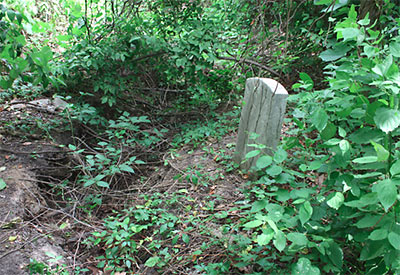 “If one of the Georges (or let’s say King George to round things out a little) happened to have been responsible for the destruction of some place — notable or otherwise, regarded as new or old at that particular moment in time — is that not an event deserving the adjective historical? Why must history be construed to reflect the addition to some facet of our tangible world, and never a subtraction from it? Is a repository of construction waste not historic simply because it lacks gingerbread affectations? If cemeteries can be historic, then why not a dump? . . . As a society, I think that we must acknowledge that the physical manifestation of our civilization is an ongoing work in progress. We should not mortgage our future to honor the past in this way.” [TheNiche, commenting on Comment of the Day: History is in the Eye of the Deedholder; previously on Swamplot] Photo of eroded grave in Olivewood Cemetery, ca. 2010:  J.R. Gonzales
“If one of the Georges (or let’s say King George to round things out a little) happened to have been responsible for the destruction of some place — notable or otherwise, regarded as new or old at that particular moment in time — is that not an event deserving the adjective historical? Why must history be construed to reflect the addition to some facet of our tangible world, and never a subtraction from it? Is a repository of construction waste not historic simply because it lacks gingerbread affectations? If cemeteries can be historic, then why not a dump? . . . As a society, I think that we must acknowledge that the physical manifestation of our civilization is an ongoing work in progress. We should not mortgage our future to honor the past in this way.” [TheNiche, commenting on Comment of the Day: History is in the Eye of the Deedholder; previously on Swamplot] Photo of eroded grave in Olivewood Cemetery, ca. 2010:  J.R. Gonzales
COMMENT OF THE DAY: HISTORY IS IN THE EYE OF THE DEEDHOLDER  “Demolish your great aunt’s soup tureen! Every person wants to preserve her or his family history, yet is bonkers to bulldoze the neighbor’s. BS. All of it is Houston’s history — whether, or not, George Washington or George Bush slept there.” [movocelot, commenting on Texas May Demolish Your Local Preservation Laws] Illustration of demolished historic structure: Lulu
“Demolish your great aunt’s soup tureen! Every person wants to preserve her or his family history, yet is bonkers to bulldoze the neighbor’s. BS. All of it is Houston’s history — whether, or not, George Washington or George Bush slept there.” [movocelot, commenting on Texas May Demolish Your Local Preservation Laws] Illustration of demolished historic structure: Lulu
TEXAS MAY DEMOLISH YOUR LOCAL PRESERVATION LAWS 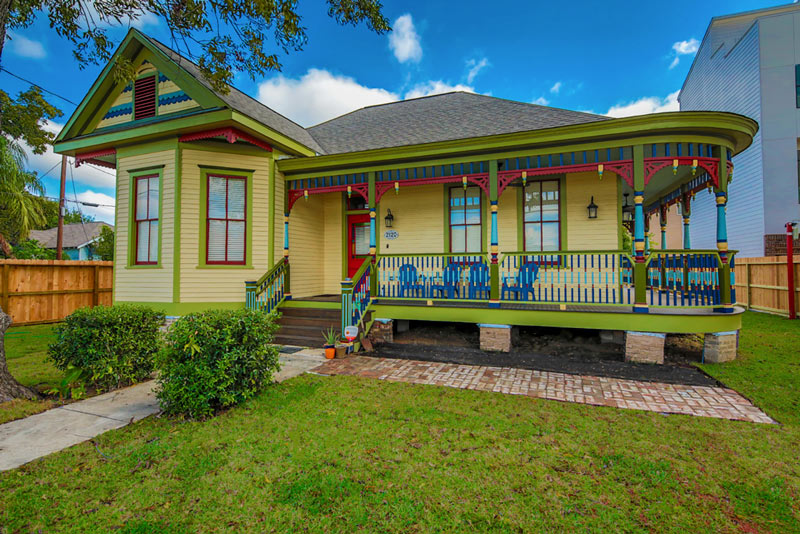 Ever worry that Houston’s historical preservation rules are just too darn strict? Tired of having to wait a whole 90 days to go ahead and do whatever you were going to do anyway to that non-protected city landmark? A public hearing has been scheduled for next Tuesday in Austin on a state bill that would gut and restructure local historic preservation procedures across Texas. The bill, as Preservation
Ever worry that Houston’s historical preservation rules are just too darn strict? Tired of having to wait a whole 90 days to go ahead and do whatever you were going to do anyway to that non-protected city landmark? A public hearing has been scheduled for next Tuesday in Austin on a state bill that would gut and restructure local historic preservation procedures across Texas. The bill, as Preservation Houston Texas put it to VBX‘s Adolfo Pesquera last month, “clumsily attempts to impose a woefully old-fashioned ‘George Washington slept here’ standard of historical significance:” The measure appears to limit new historical designations to either 1) structures lived in by a famous person or 2) places where something “widely recognized as a historic event” happened. (Under that standard, the Astrodome might make the cut for Evel Knieval’s 13-car motorcycle jump.) Houston’s own District 135 rep Gary Elkins is the only sponsor of the measure, which would also require that any movements to designate areas of “historical, cultural, or architectural significance” get support from 3 quarters of the city council or the local planning commission. The measure also may put the final say on any proposed changes to a protected structure in the hands of a single “municipal official,” who will have 30 days to give a yea or nay. [Virtual Builder’s Exchange; bill here; previously on Swamplot] Photo of protected former home of August von Haxthausen at 2120 Sabine St.: HAR
THE GRAVESITE BREAKUP MYSTERY NEAR ALDINE MIDDLE SCHOOL 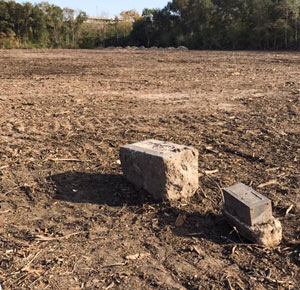 Who, exactly, ordered the unannounced, interrupted, and apparently haphazard plant and gravestone removal at the unmarked Aldine Cemetery near Aldine Middle School last week? As of Friday, Mike Snyder writes, the local sheriffs  were still trying to figure that out — as were some of the (living) family members of the buried, and unofficial Aldine historian Elizabeth Battle, who had been working to get the cemetery its own historical marker. Battle tells Snyder she’d been under the impression that “people . . . barreling in and destroying graves without contacting the descendants” wasn’t something that was likely to happen; University of Houston professor and periodic gravesite construction advisor Ken Brown notes that any disturbance of the 30-ish headstones, even by the property’s owner, should have required a court order. [Houston Chronicle] Photo of semi-cleared Aldine Cemetery on Aldine Meadows Rd: State rep. Armando Walle
Who, exactly, ordered the unannounced, interrupted, and apparently haphazard plant and gravestone removal at the unmarked Aldine Cemetery near Aldine Middle School last week? As of Friday, Mike Snyder writes, the local sheriffs  were still trying to figure that out — as were some of the (living) family members of the buried, and unofficial Aldine historian Elizabeth Battle, who had been working to get the cemetery its own historical marker. Battle tells Snyder she’d been under the impression that “people . . . barreling in and destroying graves without contacting the descendants” wasn’t something that was likely to happen; University of Houston professor and periodic gravesite construction advisor Ken Brown notes that any disturbance of the 30-ish headstones, even by the property’s owner, should have required a court order. [Houston Chronicle] Photo of semi-cleared Aldine Cemetery on Aldine Meadows Rd: State rep. Armando Walle
NATIONAL HISTORIC PRESERVATIONISTS TO GATHER IN HOUSTON, GAWK AT ASTRODOME 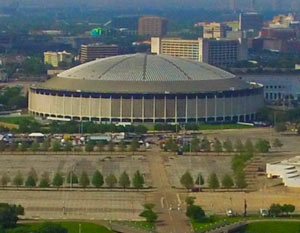 The National Trust for Historic Preservation — that’d be the folks that coined the ‘orgy of irrational destruction’ line picked up by Save the Bungalows a few years back — is holding its annual conference in Houston for the first time, starting next Tuesday. Current president Stephanie Meeks cites the city’s “compelling preservation story,” amid a regional lack of preservation-minded rules and regulations, as a reason for picking the city. Planned field trip locales include the Astrodome (currently getting ready for that basement parking garage remodel), as well as Mission Control, the artsifying warehouses and industrial facilities around Washington Ave., and a handful of Galveston historic districts. Also on the docket: the debut of the organization’s Atlas of ReUrbanism (a digital collection of built environment data aimed public officials, reporters, and other city data scavengers), for which Houston is one of 5 starter cities. Would-be attendees can catch some conference sessions next Tuesday through Friday in the neighborhood of the newly-game-faced George R. Brown Convention Center; those who don’t want to make the trip downtown can watch some sessions at home. [Previously on Swamplot] Photo of Astrodome: Russell Hancock via Swamplot Flickr Pool
The National Trust for Historic Preservation — that’d be the folks that coined the ‘orgy of irrational destruction’ line picked up by Save the Bungalows a few years back — is holding its annual conference in Houston for the first time, starting next Tuesday. Current president Stephanie Meeks cites the city’s “compelling preservation story,” amid a regional lack of preservation-minded rules and regulations, as a reason for picking the city. Planned field trip locales include the Astrodome (currently getting ready for that basement parking garage remodel), as well as Mission Control, the artsifying warehouses and industrial facilities around Washington Ave., and a handful of Galveston historic districts. Also on the docket: the debut of the organization’s Atlas of ReUrbanism (a digital collection of built environment data aimed public officials, reporters, and other city data scavengers), for which Houston is one of 5 starter cities. Would-be attendees can catch some conference sessions next Tuesday through Friday in the neighborhood of the newly-game-faced George R. Brown Convention Center; those who don’t want to make the trip downtown can watch some sessions at home. [Previously on Swamplot] Photo of Astrodome: Russell Hancock via Swamplot Flickr Pool
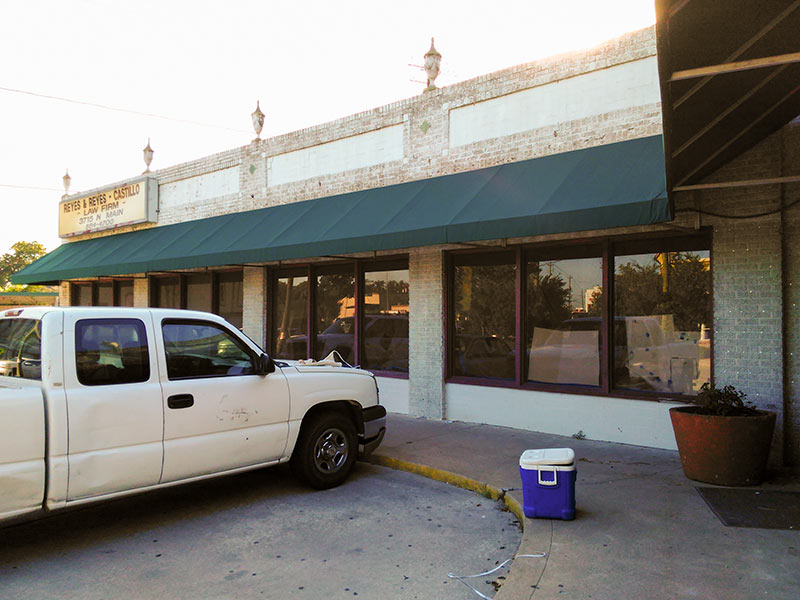
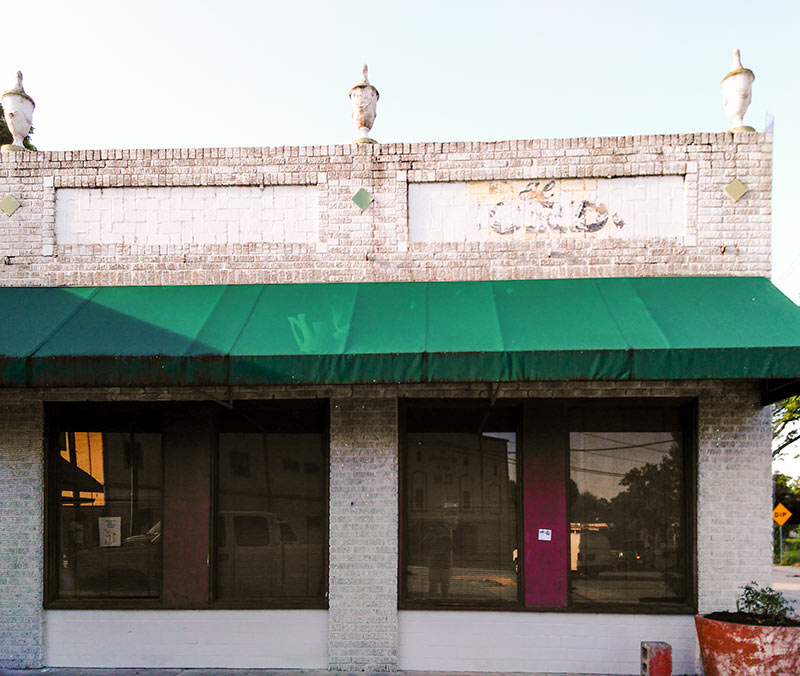
Workers have begun attaching wire netting to the façade of the 4,344-sq.-ft. retail-turned-office building at 3715 N. Main, which county records indicate was built in 1940 and a nearby resident believes once served as a post office for the adjacent neighborhoods of Norhill and Brooke Smith. The netting is in advance, it appears, of a new stucco or stucco-like overcoat for the brick-front structure.
The Iglesia de Restauracion, an affiliate of El Salvador-based pentecostal ministry Mision Cristiana Elim Internacional, bought the building last fall; previously it served as the law offices of voting-rights attorney Frumencio Reyes. In stuccoing the structure, the neighborhood church will be following the pattern established earlier with the successive stuccovers of its own main sanctuary building, the former North Main Theater across the street at 3730 N. Main.
Here’s how that movie theater, which was built in 1936, once looked:

